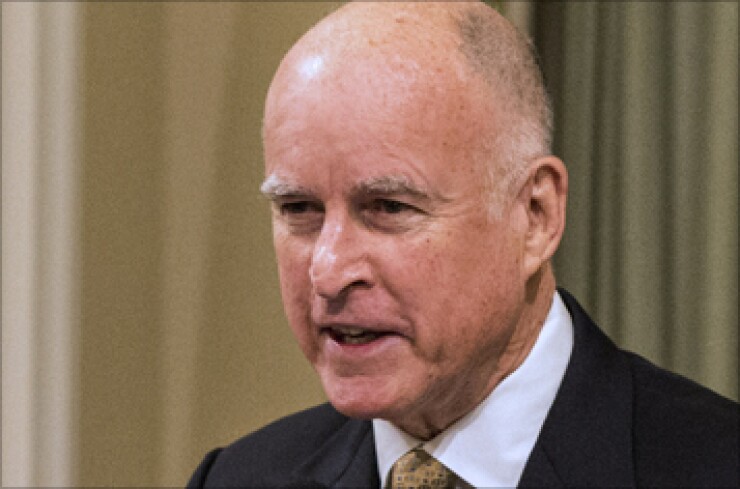
LOS ANGELES — California's state government and the federal government are ramping up funding to help struggling communities deal with a historic drought.
Gov. Jerry Brown and other legislative leaders unveiled legislation Wednesday to provide $687.4 million to support drought relief, including bond funds for projects to help local communities more efficiently capture and manage water and funds to secure emergency drinking water supplies.
"This is a call to action. We must all do our part to conserve," said Brown, a Democrat, who declared a statewide drought emergency last month and directed officials to prepare for water shortages. "The state is doing its part by providing immediate funding for drinking water, food, housing and assistance for water-conserving technologies."
Senate President pro Tem Darrell Steinberg, D-Sacramento, and Assembly Speaker John Pérez, D-Los Angeles also support the legislation.
About $549 million would come from an accelerated expenditure of already voter-approved general obligation bonds from propositions 84 and 1E, in the form of infrastructure grants for local and regional projects that are already planned or partially completed, to increase local reliability.
"Water agencies around the state have projects ready to go to capture and distribute more of the water that's now lost to evaporation or simply flowing out to the ocean," Steinberg said. "They simply need money to get those projects done."
Voters approved Proposition 84 in 2006, authorizing $5.388 billion in GO bonds to fund safe drinking water, water quality and supply, flood control, and other water-related efforts.
Proposition 1E, also approved in 2006, authorizes $4.09 billion in GO bonds to rebuild and repair California's most vulnerable flood control structures, and to protect the state's drinking water supply system.
Projects that would be funded by the governor's proposed legislation include recapturing storm water, expanding the use and distribution of recycled water, enhancing the management and recharging of groundwater storage, and strengthening water conservation.
Other funds would be transferred from the Greenhouse Gas Reduction Fund and the Greenhouse Gas Emissions Fund to the Department of Water Resources and the Department of Food and Agriculture for water-related projects.
The legislation also includes $46.3 million from the General Fund for food and housing assistance for those affected by the drought.
Several of the proposals included in the package were proposed in Brown's January budget, but would now be expedited. The legislation must still pass through both houses of the Legislature before getting a signature from the governor.
The announcement comes just days after Brown joined President Barack Obama and other federal officials in the Fresno area for a discussion with farmers and other local stakeholders affected by the drought.
There, Obama announced as much as $15 million in federal assistance for California and other states that are in extreme drought, as well as the acceleration of $100 million of funds from the 2014 farm bill he signed earlier this month.
That would build upon the $20 million that the U.S. Department of Agriculture already said it would provide in assistance to support water conservation efforts by California farmers.
"These actions will help, but they're just the first step," Obama said in Los Banos, Calif. "We have to be clear: A changing climate means that weather-related disasters like droughts, wildfires, storms, floods are potentially going to be costlier and they're going to be harsher."
The Obama administration has been taking steps toward increasing weather-related funding for local communities, as California's record drought and the expensive fallout from other recent natural disasters has heightened the need for federal support at the state and local level.
The president announced on Feb. 14 that he plans to send a budget to Congress next month that will include $1 billion in new funding to help communities prepare for a changing climate and set up incentives to build more resilient infrastructure.
Obama also created a Task Force on Climate Preparedness and Resilience in November to advise on how the federal government can respond to the needs of communities that are dealing with the impacts of climate change.
The task force met for the second time Feb. 13 at the Los Angeles City Hall.
Senior Obama administration officials included Nancy Sutley, White House Council on Environmental Quality chair; David Agnew, deputy assistant to the President and director of intergovernmental affairs; Gina McCarthy, Environmental Protection Agency administrator; and David Poneman, U.S. Department of Energy deputy secretary.
Gov. Brown and Los Angeles Mayor Eric Garcetti were among the state, local, and tribal leaders who conferred with federal officials in the closed-door meeting.
"This climate change is overwhelming — it's a huge and expensive and difficult challenge," Brown said during a press conference after the meeting. "California is leading the country and leading most of the other nations, but we can't do it alone."
To give an idea of just how expensive climate change is, Sutley pegged the cost of weather disasters in the United States during 2012 at $112 billion.
"And as we speak a number of Western states are facing drought conditions, including an historic drought here in California," said Sutley, who co-chairs the task force with Agnew. "Federal agencies have partnered with Gov. Brown to ramp up funding and to take immediate actions to try to lessen the impacts on California communities, but we also have to look at ways to better prepare ourselves for these kinds of events happening more frequently in the future."
Garcetti said the task force meetings focus on three things: coordination among the federal, state, and local governments to plan and prevent or mitigate natural disasters; creating a list of best practices in dealing with these issues to share with other states and local governments, and coming up with concrete goals to improve resilience to climate change.
Another goal is showing that this is an issue about people — that the impact of climate change is felt locally.
"Here in Los Angeles we feel that when we are threatened with rising ocean levels which would endanger the economic output of our port which accounts for 43% of the goods that come into America," Garcetti said. "We feel that and see that when there are local fires in drier and drier years and the impact that has on our local resources and on our air quality."
Illinois has also felt the effects of climate change, said Gov. Pat Quinn, who joined Garcetti and Brown at the meeting.
"We had devastating floods in April, we had deadly tornadoes in November — people lost their lives, one community lost over 1,000 homes — and now in the winter in January we've had tremendous cold and great snow and have had to deploy the National Guard on many occasions to deal with these weather emergencies," Quinn said. "So that ought to be an alarm bell to all of us in America."
Sutley said the task force is focusing on areas where they see opportunity for coordination and collaboration — whether it's getting the federal government toto remove barriers or counterproductive policies, working on disaster recovery and response, or investing in infrastructure.
The task force is continuing to develop recommendations on how the federal government can support transportation projects at the local level, she said.
This is especially important as the Highway Trust Fund, which supports roads and surface transportation projects across the nation, will be insufficient at current funding levels to pay for new projects in 2015 or even keep up with wear and tear on existing roads.
The fund has traditionally been supported by revenue from federal motor fuel taxes, but these have been declining for years as cars become more energy efficient.
The federal government already spends "billions and billions" of dollars to help support infrastructure investments across the country, Sutley said, whether it's for transportation, soil conservation, water resources, or wastewater and drinking water treatment.
"The importance here is to ensure that when we spend that money as a country and support the communities, that we're doing it in a way that makes us resilient for the long term and deals with impacts of climate change," Sutley said. The task force, which includes governors from six other states, 13 other mayors, and four local and tribal officials, will continue with more meetings and small group discussions before giving recommendations to the president at the end of the year, Sutley said.





